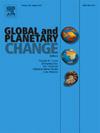Mercury enrichments as a paleo-volcanism proxy: Sedimentary bias and a critical analysis across the end-Triassic
IF 4
1区 地球科学
Q1 GEOGRAPHY, PHYSICAL
引用次数: 0
Abstract
Mercury (Hg) anomalies in sedimentary rocks have been increasingly used in paleoclimatology studies for tracing volcanic signals, as Hg emissions from volcanic activity can cause contemporaneous sedimentary Hg enrichment. However, non-volcanic sedimentary controls on Hg have clear potential to mask these signals. These factors include host phase variability linked to environmentally controlled sourcing and settling changes, and/or variable preservation conditions associated with weathering, oxidation and diagenesis. Such factors can limit the efficacy of Hg as a paleo-volcanism proxy. In this study, sedimentary effects on Hg concentration within a complex depositional system in southwest England (St. Audrie's Bay) across the end-Triassic have been analyzed, together with published data from coeval end-Triassic sections globally – an interval of time coeval with the Central Atlantic Magmatic Province (CAMP). Our statistical analysis of Hg and associated geochemical data highlights significant fluctuations in sedimentary Hg due to relative supply differences in Hg and host phases, as well as the changing types and preservation conditions of host phases. End-Triassic sections globally show a consistent undersupply of Hg relative to organic matter across the end-Triassic mass extinction (ETME). To better assess the magnitude and significance of possible Hg enrichments in sedimentary rocks, we present a statistical method for quantifying Hg anomalies to robustly distinguish Hg variations linked to host phase/depositional changes from paleo-volcanism. Our method supports the existence of transient but asynchronous Hg anomalies linked to volcanism from the CAMP across the end-Triassic in most global sections, albeit not in the St. Audrie's Bay section.
作为古火山活动替代物的汞富集:沉积偏差和对整个三叠纪末的批判性分析
在古气候学研究中,沉积岩中的汞(Hg)异常被越来越多地用于追踪火山信号,因为火山活动的汞排放会造成同期沉积岩的汞富集。然而,非火山沉积对汞的控制显然有可能掩盖这些信号。这些因素包括与环境控制的来源和沉降变化有关的主相变化,和/或与风化、氧化和成岩作用有关的保存条件变化。这些因素会限制汞作为古火山作用替代物的有效性。本研究分析了英格兰西南部(圣奥德里湾)三叠纪末一个复杂沉积系统中沉积作用对汞浓度的影响,以及全球同时期三叠纪末剖面(与中大西洋岩浆省(CAMP)同时期)的公开数据。我们对汞和相关地球化学数据的统计分析结果表明,由于汞和寄主相的相对供应差异,以及寄主相类型和保存条件的变化,沉积汞出现了显著波动。全球三叠纪末断面显示,在整个三叠纪末大灭绝(ETME)期间,相对于有机质而言,汞的供应始终不足。为了更好地评估沉积岩中可能存在的汞富集的程度和意义,我们提出了一种量化汞异常的统计方法,以便从古火山活动中有力地区分与宿主相/沉积变化有关的汞变化。我们的方法证明,在全球大部分地段,尽管圣奥德里湾地段不存在与三叠纪末CAMP火山活动有关的瞬时但不同步的汞异常。
本文章由计算机程序翻译,如有差异,请以英文原文为准。
求助全文
约1分钟内获得全文
求助全文
来源期刊

Global and Planetary Change
地学天文-地球科学综合
CiteScore
7.40
自引率
10.30%
发文量
226
审稿时长
63 days
期刊介绍:
The objective of the journal Global and Planetary Change is to provide a multi-disciplinary overview of the processes taking place in the Earth System and involved in planetary change over time. The journal focuses on records of the past and current state of the earth system, and future scenarios , and their link to global environmental change. Regional or process-oriented studies are welcome if they discuss global implications. Topics include, but are not limited to, changes in the dynamics and composition of the atmosphere, oceans and cryosphere, as well as climate change, sea level variation, observations/modelling of Earth processes from deep to (near-)surface and their coupling, global ecology, biogeography and the resilience/thresholds in ecosystems.
Key criteria for the consideration of manuscripts are (a) the relevance for the global scientific community and/or (b) the wider implications for global scale problems, preferably combined with (c) having a significance beyond a single discipline. A clear focus on key processes associated with planetary scale change is strongly encouraged.
Manuscripts can be submitted as either research contributions or as a review article. Every effort should be made towards the presentation of research outcomes in an understandable way for a broad readership.
 求助内容:
求助内容: 应助结果提醒方式:
应助结果提醒方式:


